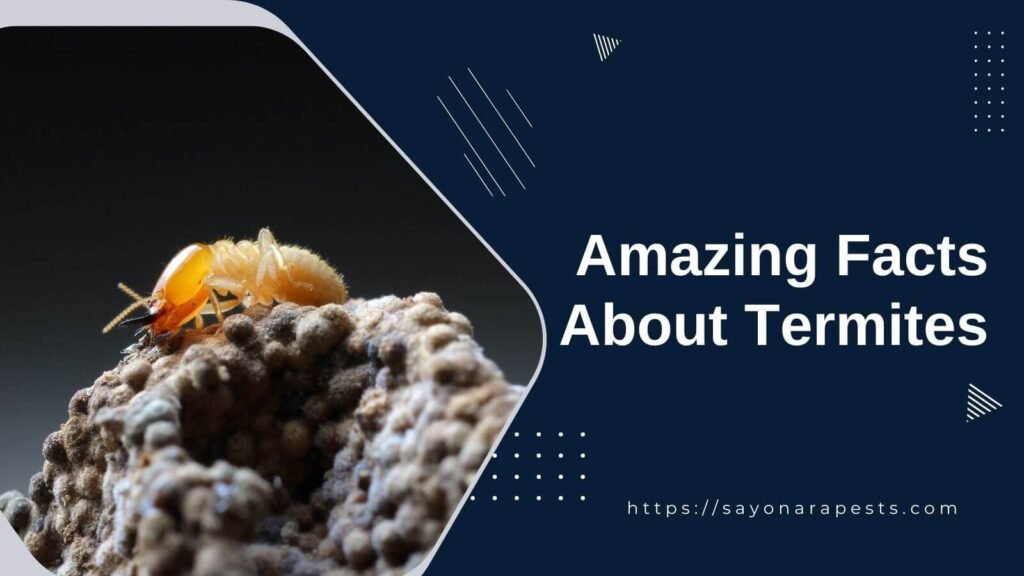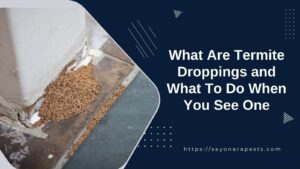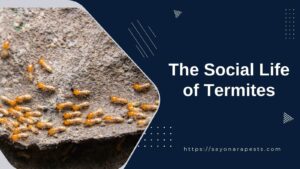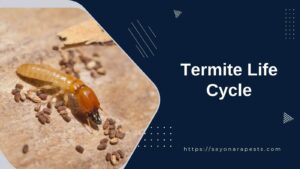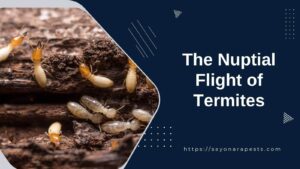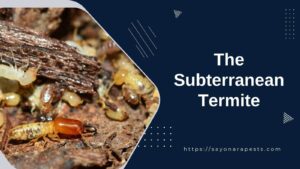Termites are fascinating insects widely known for their destructive abilities to structures and homes. However, beyond this destructive behavior are things we don’t know much about them.
In this article, we will discuss some facts about termites that we might not know yet. However, these facts help us understand them more and what they usually do as insects in this world
Fact #1: Termites Have Their Social Structure
Termites damage wooden structures. However, their unique social system makes them stand out from other insects.
These tiny insects live in colonies that are very well run and work as a single unit to make sure they survive and do well. Each termite colony comprises different groups of termites called “castes.” Each caste has a specific job and set of responsibilities.
The king and queen, part of the reproductive caste, are the most essential termite colony members. The king and queen are in charge of making babies and keeping the colony’s population stable.
They stay with the same partner for life and are the only ones who can have children. This keeps their lineage going.
The queen is fascinating because she can lay thousands of eggs in a single day, which helps the colony multiply.
Soldier termites protect the colony from threats, such as ants or other predators, when the reproductive caste makes more termites. These soldiers use their large, strong jaws to fight off attackers.
They are significant to protecting the colony and keeping it safe.
Worker termites are another essential caste. These hard-working termites are responsible for things like finding food, building and fixing the nest, and caring for the eggs and young termites.
They are very good at what they do and can make complex tunnel systems in wood or soil to protect themselves and get resources.
Each group works together to ensure the colony stays alive and grows. Termites can live in many different places worldwide thanks to their complex system of working together and sharing tasks. This shows how well these tiny, seemingly insignificant creatures adapt to their surroundings.
Fact #2: Termite Queens Can Live For Up To 50 Years
One of the most astonishing facts about termites is the remarkable lifespan of their queens. While the lifespan of most insects is relatively short, termite queens have exceptional unparalleled longevity in the insect world.
In some termite species, the queen can live for up to an astonishing 50 years, making her one of the longest-lived insects on the planet.
The longevity of termite queens is crucial for the survival and prosperity of the colony. As the primary reproductive member, the queen is responsible for laying eggs and maintaining a steady population within the territory.
Her ability to produce many offspring over an extended period is essential for the colony’s growth and resilience.
The secret behind the queen’s remarkable lifespan lies in the controlled aging process within the termite colony.
Unlike most organisms, termites possess a unique mechanism called “cryptobiosis,” allowing them to enter a state of suspended animation when conditions are unfavorable. This state of dormancy helps them conserve energy and prolong their lifespan.
Additionally, termite queens have optimal conditions and nourishment within the colony, ensuring longevity. They are constantly tended to by worker termites, who feed and groom them, ensuring their well-being and reproductive success.
The queen’s specialized diet, consisting of highly nutritious substances the workers produce, further contributes to her extended lifespan.
The ability of termite queens to live for several decades showcases the incredible resilience and adaptability of these insects and highlights the importance of their role in maintaining termite colonies.
Their longevity ensures the continuity and stability of the colony, allowing it to thrive and persist over generations.
Fact #3: Termites Are Useful In Our Ecosystems
Even though termites are often blamed for damage to buildings and financial losses, it’s important to remember the vital role they play in our ecosystems. These tiny creatures help keep the balance and health of natural environments in many ways.
Termites are essential decomposers because they break down dead plants and put nutrients back into the soil.
In termites’ anatomy, termites have a particular digestive system that lets them quickly and easily break down cellulose, a complex part of plant fibers. When termites eat decaying wood, leaves, and other organic matter, they speed up the process of decomposition and the recycling of nutrients.
By doing this, they put essential things like nitrogen, phosphorus, and potassium into the soil, making it richer and helping plants grow.
Termites not only break down dead things, but they also feed many other organisms in the ecosystem, which is an essential part of their job. Termites are a big part of the diet of many animals, including birds, reptiles, amphibians, and small mammals.
By being food for these predators, termites are a part of the complex web of life and help keep their numbers up.
Also, termite mounds and nests create small environments home to many different kinds of organisms. Many insects, spiders, and other small invertebrates find shelter and safety in termite mounds because of their complex design.
Most of the time, these microhabitats have different moisture levels and temperatures that help certain plant species survive and add to the overall diversity of the ecosystem.
To understand the role termites play in keeping the balance of natural systems, you need to know how they affect the environment.
Even though termites can be a problem in some situations, it’s essential to recognize and value the important things they do for our ecosystems.
Fact #4: Termites Can Build Their Mounds And Nests
Termites’ ability to build mounds and nests is one of the most impressive engineering feats in the insect world. Termites have the fantastic ability to create complex structures that serve as their homes and give them a safe place to live and grow.
Termite mounds can be different sizes, shapes, and levels of complexity depending on the type of termite and where it lives.
Termite workers usually build by gathering soil, bits of wood, saliva, and other things to make a mixture called “termites’ cement.” This mixture is then used to build tunnels and rooms inside the mound that are very complicated.
Termite mounds are very well made. They have a variety of architectural features that serve different functions.
Mounds often have ventilation shafts and chimneys that control airflow and keep the nest at the right temperature and humidity level. These things help termites make a microclimate that helps them stay alive and helps their young grow up.
Also, different types of termites can build their nests above or below the ground. For example, subterranean termites create complex underground tunnel networks that link their nests to food sources.
These tunnels protect the termites from predators and the weather and make finding food more accessible.
The way the termite colony works together to build mounds and nests is a fantastic example of group behavior and cooperation. Termite workers work hard all day long, and each one contributes to the building.
They use their instincts and knowledge to build complex structures that work.
Human architects and engineers have been inspired by how termites build their homes. This is because studying termite architecture can teach us a lot about good ventilation systems, how to control temperature, and how to build in a good way for the environment.
Scientists and architects can develop new ways to design and plan cities as efficient and robust as termite mounds by figuring out how termites build their mounds.
Fact #5: Termites Eat All the Time
Termites are very dedicated and hungry when it comes to what they eat. These interesting bugs have an insatiable hunger and are known to eat nonstop, 24 hours a day, 7 days a week.
Termites have changed over time to become efficient and constant consumers of cellulose-based materials like wood, leaf litter, and plant fibers. This is different from many other animals that only eat at certain times.
Termites have a particular digestive system that lets them break down cellulose, a complex plant carbohydrate. Termites have a mutualistic relationship with microorganisms, like bacteria and protists, that live in their guts.
This helps them do their job. These microorganisms make enzymes that can break down cellulose. This makes it possible for termites to get nutrients from material that would not usually be digestible.
Termites always eat because they have high metabolic rates and need constant energy. Termites often build foraging tunnels and galleries that lead from their nests to places where they can get food.
These complicated networks help them find and gather resources quickly to feed their insatiable hunger.
Even though termites eat all the time, they are actually doing important things for the environment. By eating dead plant parts, termites help the nutrient cycling process, which involves breaking down dead plant parts and putting essential elements back into the soil.
Their constant search for food also helps break down woody debris, which helps recycle organic matter and keep ecosystems in balance.
Fact #6: Some Termites Love Fungi
Termites and what they like to eat vary, with some species being especially fond of fungi. People often call these termites “fungus-growing” or “agricultural” termites, and they have made friends with some types of fungi that help them both.
Fungus-growing termites grow specific kinds of fungi in their nests in unique gardens. These fungi are their primary food source.
The termites give the fungi a steady supply of organic matter, like plant matter, which the fungi break down and turn into a food source called a substrate. In exchange, the fungi give the termites an easy-to-digest food source that helps to round out their diet.
Termites and fungi have a very complicated and mutually beneficial relationship. Termites carefully choose and care for the fungi in their gardens, ensuring they grow and produce at their best.
They make controlled environments with the right temperature and humidity to help the cultivated fungi grow.
Fascinatingly, the fungi that termites grow have changed over time so that they can only spread and live because of the termites.
The termites eat “gongylidia,” unique structures these fungi make. In turn, the termites drop fungal spores in their droppings, which helps the fungi spread to new places and take hold there.
How fungus-growing termites farm is an excellent example of mutualism and advanced farming techniques in the insect world. By growing fungi, these termites have made a reliable and efficient food source for their colonies that helps them stay alive and grow.
Fact #7: Termites Are All Over The World Except For Antarctica
Termites can be found on many different continents and in many kinds of ecosystems. These hardy insects have been able to live in many other places worldwide by adjusting to different climates and environments.
But Antarctica is a significant exception to their reach around the world.
Antarctica is still not a good place for termites because it is so cold and harsh. Termites can’t live on this cold continent because it’s too cold, and there aren’t enough good resources.
The fact that there are no termites in Antarctica shows how limited their ability to change is and how important environmental factors are in deciding where they live.
On the other hand, termites live on every other continent, including North and South America, Africa, Asia, Europe, and Australia. They live in tropical, subtropical, and temperate areas, which are essential parts of ecosystems and can sometimes be a problem in the home.
Their ability to change and do well in different climates shows how strong and successful they have been at evolving.
Fact #8: Termites Communicate With Each Other Using Chemical Signals
Any social organism needs to be able to talk to each other, and termite communication allows termites to talk to each other and coordinate their activities within the colony. In contrast to humans, termites mostly use chemical signals called pheromones to share information and work together.
Termites send out pheromones, which are chemicals, into their environment. Each pheromone has a specific job and makes other termites act similarly.
Chemical signals can tell termites many different things, like when they are in danger, where food is, who their nestmates are, and when it is time to start reproducing.
Termites can lead other termites to food sources by leaving pheromones along the paths they use to find food. Because of how well they can talk to each other, they can share resources and ensure the whole colony’s survival.
Pheromones are also crucial for social cohesion because they help termites distinguish between their nestmates and other termites.
Fact #9: Termites Can Be Altruistic
Altruism is selfless care for the well-being of others. It is a characteristic of social organisms. Even though termites are tiny, they show interesting examples of helping each other in their colonies.
The behavior of the worker caste, which makes up most of a termite colony, is a good example of how termites help each other.
Worker termites look for food, build and repair the nest, and care for the young. They do these things without thinking about themselves, often at the cost of their own ability to reproduce and stay alive.
In many species of termites, the workers are sterile and can’t reproduce, so they spend their whole lives serving the colony’s needs.
The fact that worker termites do things that help the whole colony shows just how selfless they are. For example, if the nest is broken into or disturbed, some workers may kill themselves by blocking the entrance or attacking intruders to protect the rest of the colony.
This selfless behavior keeps the whole termite colony alive and healthy, even if it means some workers die.
Fact #10: Termites Can Show Cannibalistic Behavior
Termites usually eat wood and plants, but sometimes they eat each other. Termites can eat each other when they don’t have enough food, are stressed out, or if there are problems in the colony.
Termites usually eat dead or hurt members of their colony when they act cannibalistic. When there aren’t enough food sources, termites may eat each other to get the nutrients they need to keep the colony alive.
This behavior helps the colony reuse resources and avoid a buildup of dead bodies, which could spread disease or attract dangerous animals.
Some termite species have developed “soldier” caste members with more enormous jaws, which is interesting.
These soldiers are made to protect the colony from threats, like termites from other colonies that try to move in. In the worst cases, soldiers may attack and eat termites from rival colonies.
Termites don’t usually eat each other, and when they do, it’s generally because they have no other choice or because of a specific situation. It’s a way for the colony to stay alive and helps them adapt to and deal with challenging situations.
Frequently Asked Questions (FAQs)
Are Termites Blind?
Termites aren’t totally blind, but they can’t see much. They have two kinds of eyes that let them tell the difference between light and dark, but they can’t see very well.
Most of the time, termites use their other senses, like touch and chemical signals, to find their way around and talk to each other.
Do Termites Never Sleep?
Termites don’t sleep like people, and some other animals do. They are always working and looking for food, so they are busy 24 hours a day.
But termites have times when they do less work, which could be considered a form of rest. During these times, they may move more slowly to save energy, but they stay alert and ready to act on any threats or chances that come their way.
What Color Attracts Termites?
Termites are not attracted to any one color in particular. Their primary interest is in cellulose, the central part of wood and other plant matter. Termites look for food based on whether it has cellulose, not because of its color.
Can You Get Poisoned By Termites?
Termites themselves do not pose a direct poisoning risk to humans.
Do Termites Smell?
Termites talk to each other by sending out chemical messages called pheromones. Even though termites don’t have a strong smell on their own, the pheromones they make can have a strong smell.
On the other hand, the smell of termites or their pheromones is hard for humans to pick up without special equipment.
Do Termites Have A Favorite Wood?
Termites do not have a single favorite type of wood. Their preference for wood depends on the species of termites and the specific environmental conditions they inhabit.
Some termites may prefer certain types of wood over others, but in general, they can consume a wide range of wood species.
Are Termites Harmless?
Termites are usually considered pests because they can do a lot of damage to buildings and other things made of wood.
Even though termites don’t hurt people or pets directly, the way they eat can weaken buildings’ structure, leading to expensive repairs.
Do Termites Eat Anything?
Most people know termites for their ability to eat and break down cellulose found in wood, leaves, and grass.
But termites have also been seen eating things like paper, cardboard, insulation, and even plastic. With the help of symbiotic microorganisms in their digestive systems, they can break down cellulose and get nutrients from many different sources.
What Do Termites Hate?
Termites are not known to have specific dislikes or aversions. However, certain termite preventive measures can help deter these insects from infesting a property.
These measures include reducing moisture accumulation in and around buildings, removing wood debris from the vicinity, maintaining proper ventilation, and ensuring regular inspections for early detection of termite activity.
Do Termites Bite People?
Most of the time, termites don’t bite people. They don’t have parts of their mouths that can bite or chew through human skin.
Overall, termites are interesting yet annoying pests different from other common insects.
By being aware of certain truths about them, we can take a step further in understanding these insects, which we can use to fight against them.

